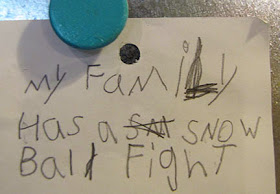The Museum is partnering with Brown University on a three-year National
Science Foundation-funded project (award #1223777) to study how children develop scientific thinking skills and understand their own learning processes. Museum researcher Suzy Letourneau is investigating how to
make kids’ learning through play visible and shared this project update.

This summer, we observed over 80 families to find out how children show
that they are thinking and learning through play in the Museum, in their
interactions with exhibit materials and with other people. We looked
for behaviors that scientists and educators have identified as important
for children’s thinking and learning, especially how children show
independent and creative thinking and metacognition – their awareness of
their own thought processes as they play. This skill includes not only
“thinking about thinking” (for example, when you know that you’ve
learned something before) but also the ability to plan, to solve
problems strategically, and to reflect on your actions.
Scientists have found that children practice these skills through play,
and that even very young children (as young as age 3) demonstrate early
foundations of metacognition and independent thinking through their
behavior, expressions, and body language. For example, even though a
toddler might not be able to articulate what she is thinking, she might
intentionally gather materials before starting to play, or
systematically try one object after another. As children get older, they
are able to describe their ideas, thoughts and plans, and they can
share what they have learned with others.
In our observations, children showed many of these “thinking behaviors”:
They explored, planned, and set goals for themselves. Before deciding
what to do, children explored in many different ways. Some rapidly tried
many different objects, some watched what others were doing, and others
looked at the exhibit from a distance. Once they had explored the
environment, 21% of children stated a plan or idea out loud before
beginning to play (
“Let’s make a space shuttle!” “This will be the
starting line.”); those who did were more likely to reflect on their
accomplishments later. Children often announced their plans without any
prompting from others. Instead, seeing how other children were playing,
seeing examples of what others had made, or just seeing loose materials
seemed to inspire them generate their own ideas. This shows why their
initial explorations of the environment might be so important.
They focused and monitored their own behavior. We often observed
children deeply focused on what they were doing, either working side by
side with others or seemingly in their own world; 36% of children showed
intense concentration. They stopped periodically to share their work
with a family member or friend and then returned to what they were
doing, often staying in one spot for a long time! Parents and caregivers
were often supportive (and patient!) bystanders, offering encouragement
when kids shared their work, stepping back and just watching, or by
playing alongside their children. For example, an 8-year-old girl in
ThinkSpace carefully created a huge sphere out of Jovos, ignoring
everyone around her. Later, she lifted it up to show her mother and
sister, who sat next to her building their own structures.
Research has shown that when activities are challenging, children are
more engaged and focused, more motivated to learn, and more confident
and proud when they succeed.
They strategized and figured things out for themselves. Children used
various strategies to solve problems or figure out how something worked.
Many kids (59%) repeated actions over and over and observed the results
each time, 41% learned from their mistakes or through trial and error,
and 40% built off of something they had seen. Most children preferred to
do things on their own; only 14% asked for help.
Children often talked about what they were doing with other children or
with their grownups; we observed 34% of children “thinking out loud.”
Sometimes they’d notice problems (
“It’s stuck!” “Where did it go?”
“Wait, this one has holes in it!”), or propose solutions (
“We need more
beanbags.” “I’m trying to find a bigger ramp.” “What if this piece
goes over there?”). At other times children’s descriptions gave us a
glimpse of what was going on in their imaginations (
“It’s a four-eyed
lion!” “It’s like a castle. This is the gate to get in. You can wipe
your feet right there.”)
Children tended to think out loud when they collaborated with others,
working toward a common goal and coordinating their efforts. In these
situations, 30% gave directions to others (“
Put that piece up there.”
“Wait, not yet!” “Ready? 1, 2, 3, go!”). Sometimes children
collaborated with and directed their grown-ups too, and caregivers
helped by asking questions or obediently following children’s
instructions.
Researchers have studied the variety of ways that children communicate
with one another as they play (directing, negotiating, narrating,
describing) and what their playful conversations show about their
development.
They reflected on their actions, both verbally (telling others about
what they did) and nonverbally (by carefully observing their own work,
or by expressing pride, delight, frustration, and surprise). We found
that 41% of children got others’ attention to show off their discoveries
or accomplishments (
“Hey Mom! Look what I did!” or pointing to show
someone), and 34% carefully observed their own work (for example, one
5-year-old girl built a tall tower out of unit blocks in
ThinkSpace, and
then walked all the way around it, looking at it from all angles with
satisfaction). Adults sometimes helped kids document their work by
taking a photo of the finished product.
Research shows that documenting and narrating/labeling children’s work
can help children remember and learn from their experiences. Reggio
teaching methods are based in large part on the power of documentation
of children’s works-in-progress, not just the finished product.
Check back for future Learning About Learning project updates!




































